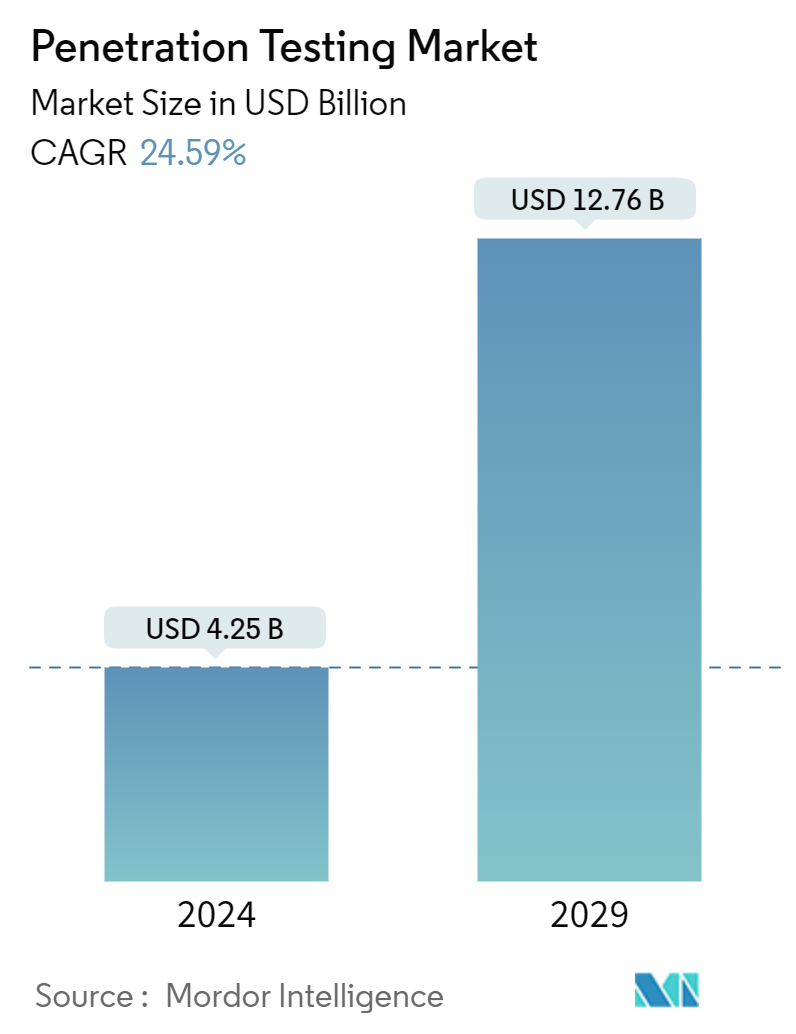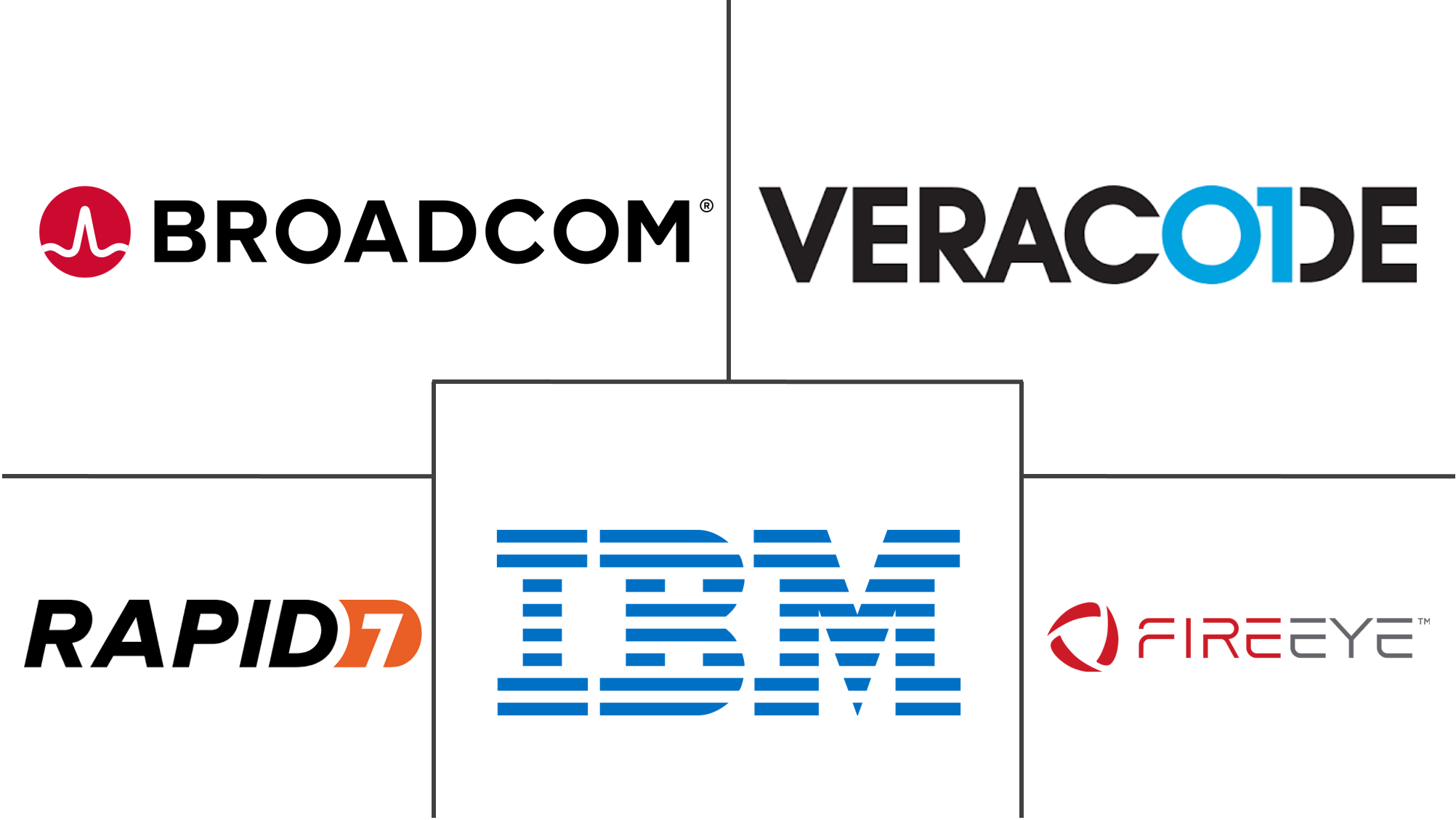Market Size of Penetration Testing Industry

| Study Period | 2019 - 2029 |
| Market Size (2024) | USD 4.25 Billion |
| Market Size (2029) | USD 12.76 Billion |
| CAGR (2024 - 2029) | 24.59 % |
| Fastest Growing Market | North America |
| Largest Market | North America |
| Market Concentration | Medium |
Major Players
*Disclaimer: Major Players sorted in no particular order |
Penetration Testing Market Analysis
The Penetration Testing Market size is estimated at USD 4.25 billion in 2024, and is expected to reach USD 12.76 billion by 2029, growing at a CAGR of 24.59% during the forecast period (2024-2029).
The penetration testing market is witnessing rapid transformation, driven by increasing security needs across industries. The growing reliance on digital technologies and online platforms has escalated the risk of cyberattacks, making penetration testing services essential for identifying vulnerabilities. Various sectors, such as government, defense, healthcare, and BFSI (banking, financial services, and insurance), are adopting penetration testing solutions to mitigate risks associated with cyber threats. Penetration testing services offer companies the ability to assess their network, application, and cloud security, ensuring compliance with cybersecurity standards and regulations.
Penetration Testing Services: Rising Demand for Security Assessments
- Penetration testing, also known as ethical hacking, focuses on identifying and mitigating security vulnerabilities in IT infrastructure. Organizations increasingly rely on penetration testing tools and services to safeguard data and ensure the robustness of their security systems. The demand for penetration testing services is fueled by the rise in sophisticated cyberattacks, regulatory requirements, and the shift toward cloud adoption.
- Key factors influencing this market include the increasing need for penetration testing automation and the evolution of testing methodologies tailored to various industries. The availability of cloud penetration testing solutions and advancements in cybersecurity compliance testing have expanded the market's scope, offering tailored services for different deployment environments, such as on-premise and cloud. Additionally, the rise of network penetration testing and application-specific testing services, including web and mobile applications, continues to shape the market landscape.
Rising Cybersecurity Risks Across Sectors
- Growing Cybersecurity Threats: The surge in security breaches has led to a significant demand for penetration testing services, especially in sectors handling sensitive data, such as finance, healthcare, and government. These industries require frequent vulnerability assessments to safeguard critical assets from increasingly sophisticated cyberattacks. With the escalation of cybercrime, the demand for cybersecurity compliance testing has grown, prompting organizations to enhance their defenses through comprehensive penetration testing tools and services.
- Ethical Hacking and Risk Assessment: Penetration testing companies offer a range of services, including ethical hacking, cyber risk assessments, and network security analysis. Cybercriminals are continually finding new ways to exploit vulnerabilities in digital ecosystems. The growing frequency and complexity of these attacks push businesses to invest in robust security measures, which has led to a steady rise in penetration testing demand.
- Cloud Security Concerns: As businesses digitize and embrace cloud technologies, they are exposed to a broader array of cyber risks. This has resulted in a surge in cloud penetration testing, where companies assess vulnerabilities in their cloud-based infrastructure. The healthcare sector, for instance, has seen a sharp rise in cyberattacks, driving a need for more rigorous penetration testing services to safeguard patient data and comply with stringent data protection regulations.
Government Regulations Driving Compliance Needs
- Compliance Mandates: Strict government regulations regarding data security and privacy are forcing organizations to adopt more sophisticated security measures. Governments worldwide are implementing frameworks to ensure that businesses adhere to strict cybersecurity standards, often mandating regular penetration testing to ensure compliance. This has become particularly prominent in the BFSI sector, where the handling of sensitive financial data demands the highest levels of security and compliance with regulatory standards such as GDPR (General Data Protection Regulation) and HIPAA (Health Insurance Portability and Accountability Act).
- Government and Defense Sector Focus: Government and defense sectors, known for their sensitive data and critical infrastructure, are increasingly dependent on penetration testing services to protect against both domestic and international cyber threats. As the digital landscape evolves, government bodies are tightening their cybersecurity compliance standards, particularly in regions such as North America and Europe. This has driven the adoption of penetration testing tools to prevent breaches and ensure the integrity of national security systems.
- Rise of Penetration Testing Automation: The complexity of modern regulatory environments, coupled with the growing volume of cyber threats, has led to a surge in demand for penetration testing automation. Automation in penetration testing enables more frequent and comprehensive assessments, allowing businesses to identify security weaknesses efficiently and stay ahead of emerging threats.
Penetration Testing Industry Segmentation
Penetration testing, also called pen testing or ethical hacking, is the practice of testing a computer system, network, or web application to find security vulnerabilities that an attacker could exploit.
The penetration testing market is segmented by type (network penetration testing, web application penetration testing, mobile application penetration testing, social engineering penetration testing, wireless network penetration testing, and other types), deployment (on-premises and cloud), end-user vertical (government and defense, BFSI, IT and telecom, healthcare, and retail), and geography (North America, Europe, Latin America, Asia-Pacific, and Middle East and Africa). The market sizes and forecasts are provided in terms of value (USD ) for all the above segments.
| By Type | |
| Network Penetration Testing | |
| Web Application Penetration Testing | |
| Mobile Application Penetration Testing | |
| Social Engineering Penetration Testing | |
| Wireless Network Penetration Testing Services | |
| Other Type |
| By Deployment | |
| On-premise | |
| Cloud |
| By End-user Industry | |
| Government and Defense | |
| BFSI | |
| IT and Telecom | |
| Healthcare | |
| Retail |
| By Geography | |
| North America | |
| Europe | |
| Asia Pacific | |
| Latin America | |
| Middle East and Africa |
Penetration Testing Market Size Summary
The penetration testing market is poised for significant growth, driven by the increasing frequency of cyber-attacks and the necessity to comply with stringent security regulations. As organizations worldwide prioritize the protection of software-based assets, such as mobile and web applications, the demand for penetration testing services is expected to rise. The proliferation of cloud-based security solutions and the surge in digitization, particularly in developing regions, are further propelling market expansion. The growing trend of Internet of Things (IoT) devices and the escalation of internet activities globally are also contributing to the heightened need for robust penetration testing. However, challenges such as a shortage of skilled professionals and limited awareness in certain regions may impede market growth.
In North America, the penetration testing market is characterized by stringent regulatory requirements and a strong commitment to cybersecurity initiatives. The region's proactive stance is reflected in its adherence to compliance testing, particularly in sectors like BFSI. Companies are increasingly investing in comprehensive security arrangements to safeguard against cyber threats, especially with the rise of remote work and digital transformation. The competitive landscape is dominated by major players like Symantec and FireEye, who are expanding their global presence through strategic innovations and collaborations. Additionally, initiatives such as Cisco's cybersecurity assessment tool and Veracode's enhanced security platform underscore the industry's focus on addressing emerging security challenges and expanding market reach.
Penetration Testing Market Size - Table of Contents
-
1. MARKET DYNAMICS
-
1.1 Market Overview
-
1.2 Introduction to Market Drivers and Restraints
-
1.3 Market Drivers
-
1.3.1 Rising Cybersecurity Risks Across Sectors
-
1.3.2 Rising Demand for Security Assessments
-
1.3.3 Government Regulations Driving Compliance Needs
-
-
1.4 Market Restraints
-
1.4.1 Lack of Awareness Regarding Penetration Testing
-
-
1.5 Industry Attractiveness - Porter's Five Forces Analysis
-
1.5.1 Threat of New Entrants
-
1.5.2 Bargaining Power of Buyers/Consumers
-
1.5.3 Bargaining Power of Suppliers
-
1.5.4 Threat of Substitute Products
-
1.5.5 Intensity of Competitive Rivalry
-
-
-
2. MARKET SEGMENTATION
-
2.1 By Type
-
2.1.1 Network Penetration Testing
-
2.1.2 Web Application Penetration Testing
-
2.1.3 Mobile Application Penetration Testing
-
2.1.4 Social Engineering Penetration Testing
-
2.1.5 Wireless Network Penetration Testing Services
-
2.1.6 Other Type
-
-
2.2 By Deployment
-
2.2.1 On-premise
-
2.2.2 Cloud
-
-
2.3 By End-user Industry
-
2.3.1 Government and Defense
-
2.3.2 BFSI
-
2.3.3 IT and Telecom
-
2.3.4 Healthcare
-
2.3.5 Retail
-
-
2.4 By Geography
-
2.4.1 North America
-
2.4.2 Europe
-
2.4.3 Asia Pacific
-
2.4.4 Latin America
-
2.4.5 Middle East and Africa
-
-
Penetration Testing Market Size FAQs
How big is the Penetration Testing Market?
The Penetration Testing Market size is expected to reach USD 4.25 billion in 2024 and grow at a CAGR of 24.59% to reach USD 12.76 billion by 2029.
What is the current Penetration Testing Market size?
In 2024, the Penetration Testing Market size is expected to reach USD 4.25 billion.

